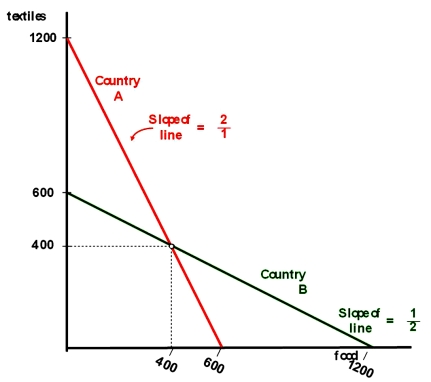Counties A and B currently consume 400 units of food and 400 units of textiles each and currently do not trade with one another. The citizens of country A have to give up one unit of food to gain two units of textiles, while the citizens of country B have to give up one unit of textiles to gain two units of food. Their production possibilities curves are shown.  Under the theory of comparative advantage, if free trade is allowed, the market clearing price (or exchange rate if you will) between food and textiles will be
Under the theory of comparative advantage, if free trade is allowed, the market clearing price (or exchange rate if you will) between food and textiles will be
A) one unit of food for one unit of textiles.
B) somewhere between One unit of food for two units of textiles and two units of food for one unit of textiles.
C) one unit of food for two units of textiles.
D) two units of food for one unit of textiles.
Correct Answer:
Verified
Q65: The doctrine of comparative advantage was first
Q66: Country A can produce 10 yards of
Q67: If you can make a good at
Q68: Which state has a comparative advantage in
Q69: Which state has an absolute advantage in
Q69: If one country is twice the size
Q72: In modern times, it is not a
Q73: Consider the no-trade input/output situation presented in
Q74: Which state has a comparative advantage in
Q75: Country A can produce 10 yards of
Unlock this Answer For Free Now!
View this answer and more for free by performing one of the following actions

Scan the QR code to install the App and get 2 free unlocks

Unlock quizzes for free by uploading documents